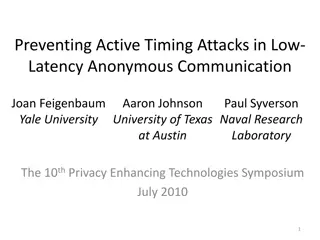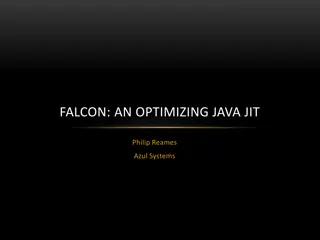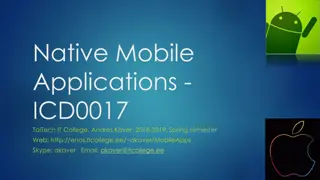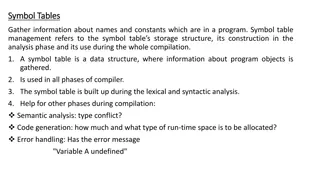
JIT Compilation Attacks in iOS
Explore the architecture and security mechanisms of iOS, delve into the basics of JIT compilation, learn about AOT vs. JIT compilation methods, and understand the vulnerabilities and exploitation techniques associated with JIT compilation in iOS.
Download Presentation

Please find below an Image/Link to download the presentation.
The content on the website is provided AS IS for your information and personal use only. It may not be sold, licensed, or shared on other websites without obtaining consent from the author. If you encounter any issues during the download, it is possible that the publisher has removed the file from their server.
You are allowed to download the files provided on this website for personal or commercial use, subject to the condition that they are used lawfully. All files are the property of their respective owners.
The content on the website is provided AS IS for your information and personal use only. It may not be sold, licensed, or shared on other websites without obtaining consent from the author.
E N D
Presentation Transcript
JIT COMPILATION ATTACKS IN IOS NULLCON GOA 2023
WHO AM I? Obviously, I am Shubham Sharma Senior Security Engineer at we45 Performs VAPT on web, API, mobile apps Course creator at AppSec Engineer related to various vulnerabilities, Cloud and AD securities Writes blogs on trendy security vulnerabilities
AGENDA iOS architecture and security mechanism Basics of JIT Compilation JIT Compilation Attacks and exploitation techniques Case studies and CVEs Mitigation techniques and counter-measures Conclusion and QnA
IOS ARCHITECTURE It has 4 layers Cocoa Touch Media Core Services Core OS
NEED TO UNDERSTAND IOS ARCHITECTURE Optimal Performance Security and Privacy User Experience (UX) Resource Management
AOT VS JIT COMPILATION AHEAD OF TIME Compiles high-level code to machine code before execution. Faster startup since the code is pre-compiled and less memory usage since there's no need for an on-device compiler. Less prone to runtime attacks since the code doesn't change after compilation. JUST IN TIME Compiles high-level code to machine code during execution. Slower startup due to on-the-fly compilation and higher memory usage as the compiler and source code might be needed in memory. More susceptible to runtime attacks, such as code injection, since code is being compiled and executed dynamically.
AOT VS JIT COMPILATION AHEAD OF TIME Apple's compilation for third-party apps due to security concerns. Therefore, AoT is the main method used in iOS development. JUST IN TIME Not development on iOS. However, Apple uses JIT for its own processes, like the JavaScript engine in Safari. Apple allowed JIT Compilation starting from iOS 14.2, only at dev build, so sideloaded apps could be JIT compiled. iOS doesn't allow JIT allowed for third-party app
BASICS OF JIT COMPILATION JIT (Just-In-Time) Compilation is the process of turning source code into native machine code just before it's executed. Advantage of JIT compilation is speed, as it can optimize the code at runtime, adapting to the specific environment it's running in. bytecode or
WHY IOS USES JIT Given the resource constraints of mobile devices, JIT allows efficient use of available system resources. JIT can make certain processes, especially JavaScript execution in web browsers, run much faster than interpreting the code.
UNDERSTANDING JIT COMPILATION IN THE CONTEXT OF SAFARI JAVASCRIPT ENGINE Safari browser on iOS devices uses the JavaScriptCore (JSC) engine to handle the execution of JavaScript code. JSC interprets and executes JavaScript code on web pages. Safari initially relied heavily on interpreted JavaScript, which was straightforward but not the most efficient in terms of speed. As web applications grew in complexity, the need for speed and efficiency became paramount.
JIT COMPILATION ATTACK The JIT (Just-In-Time) compilation involves converting bytecode into native machine code at runtime. There are few of many attack scenarios: JIT Spraying Bypassing ASLR Type Confusion Deoptimization Attacks
JIT SPRAYING JIT spraying involves feeding crafted input to a JIT compiler, causing it to generate malicious machine code that resides in executable memory regions. iOS devices, especially through the Safari browser, rely on JIT compilation for efficient JavaScript execution. With precise input, an attacker might induce the JIT compiler in Safari to generate and execute malicious payloads.
BYPASSING ASLR Address Space Layout Randomization (ASLR) randomizes memory locations to make it challenging for attackers to predict the address of specific functions or buffers. However, with JIT vulnerabilities, attackers might be able to leak memory addresses. iOS employs ASLR as one of its core security mechanisms. Exploiting weaknesses in JIT could reveal memory layouts in Safari or other JIT-reliant apps, undermining ASLR's effectiveness
TYPE CONFUSION Type confusion arises when the system misinterprets data of one type as another, potentially leading to unintended behaviors or vulnerabilities. Safari's JavaScript engine relies on type inference for optimization. Incorrect type assumptions can be exploited to cause arbitrary memory reads/writes. Such vulnerabilities can provide a foothold to attackers, enabling them to escalate privileges or execute arbitrary code.
DEOPTIMIZATION ATTACKS Safari's JavaScript engine, uses JIT compilation that relies on various optimization techniques. Crafted payload can cause aggressive optimization followed by deoptimization; attackers can potentially destabilize the system. When the system handles these deoptimizations improperly, it results in exploitable conditions, like out-of-bounds memory access or use-after-free scenarios.
PREVIOUSLY REPORTED CVES CVE-2020-27930 CVE-2020-980x CVE-2020-3862 CVE-2019-8605 CVE-2018-4192
CVE-2020-27930 Safari is susceptible to a remote code execution vulnerability via an undefined character in Type 1 fonts handled by libType1Scaler.dylib on macOS and iOS. Issue was fixed in iOS 14.2 security fix and iOS 12.4.9 update https://packetstormsecurity.com/files/161294/Apple-Safari-Remote-Code- Execution.html
CVE-2020-9802, 9803, 9805, 9806, 9807 A memory corruption and logic issue was addressed with improved state management and restriction. These vulnerabilities were part of Google s Project Zero. These were fixed with iOS 13.5 and Safari 13.1.1
WHY IS IT SO IMPORTANT? Ubiquity of iOS Devices Sensitive Data Storage Trust in the Apple Ecosystem Complexity of Modern Web Browsing Evolution of Attack techniques Securing Future Implementations
IMPACT OF JIT COMPILATION ATTACK Unauthorized Code Execution Data Leakage Bypassing Security Mechanisms Performance Degradation Reputational Damage
MITIGATION TECHNIQUE Enhanced Code Auditing Restricted JIT Execution Sanitization and Validation
FUTURE TOPIC OF RESEARCH Advanced Detection Mechanisms: Develop techniques or tools to automatically detect when a JIT process is being exploited, potentially in real-time. Deep Dive into JIT Internals: As JIT compilers become more complex, understanding their deep internal workings can reveal unforeseen vulnerabilities or avenues of attack. Holistic System Analysis: Instead of focusing solely on JIT, look at how JIT interacts with other system components. This holistic view might uncover vulnerabilities that arise from these interactions rather than JIT itself. Alternative Compilation Techniques: Research into alternatives to JIT, or hybrid approaches, that might offer the performance benefits of JIT without the associated security risks. Use advanced fuzzing techniques targeted specifically at JIT processes to discover new vulnerabilities.
THANK YOU!! Now, let s go and fill out our empty stomach with lunch outside






















